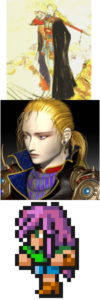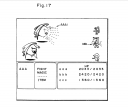Final Fantasy VI: At Long Last
Of all the Final Fantasies I’ve played — and I’ve played exactly half of the main-line titles by now — FF6 is the one that took me the longest to beat. Not because it’s a longer or tougher game than the others, but because I kept stopping. I guess this is a pretty good indicator that I didn’t find it as compelling as FF5 or FF7. The story and setting are interesting enough, but most of the time, my attention was on the mere mechanics, which just didn’t keep me interested the way FF5‘s freewheeling Jobs system did. I can blame my urge to optimize for part of that: the dual use of Espers, teaching spells continuously and raising stats when you level, meant that I spent a lot of time shuffling them around from person to person.
Ah, but I leave out the Espers’ third use, that of summonable. That’s because I was hardly ever using them that way toward the end, as my characters came to dwarf them in power. Maybe half of them knew the Ultima spell (the ultimate area-effect direct-damage spell), and most of them knew Cure 3 (enough healing power to usually restore the whole party to full health) and Life 2 (resurrect and restore to full health). These are all big mana-drains, but they also knew Osmose (absorb mana from an enemy) — something that I never used much for most of the game, but which proved useful in the three-stage boss fight against Kefka.
There’s a certain amount of philosophizing before and after the fight, with Kefka taking a garden-variety nihilistic stance, countered by Terra’s nurturing the-journey-not-the-destinationism. With his makeup and hyena’s laugh, Kefka always seemed a bit like the Joker, but when he goes into ultimate-battle mode, he adopts a more mock-angelic form that’s a clear anticipation of Sephiroth in FF7. I suppose that to people who played the games in order, it came off as Sephiroth being a variation on Kefka’s theme, but from my point of view, Kefka looks like a transitional form, a step on the way to the more familiar.
At any rate, as I had been told, the end boss fight turns out to be pretty easy once you’ve come that far and survived the other encounters in Kefka’s junkyard tower. The main obstacle to completing the dungeon is simply its length. I may be just remembering badly, but I don’t recall the final dungeon in FF7 taking anywhere near so long to traverse. And, once you’re through with it, you get the cutscenes. Just like in FF5 (or, at least, the Playstation remake of FF5 that I played), this game just doesn’t want to end. It wants to keep showing you stuff for as long as you’re willing to look at it.
Notably, there’s a series of in-engine vignettes showing the crew rushing to escape the tower before it collapses: each character (or set of related characters) gets their own little mini-sketch highlighting their role in the story — yes, even Gogo and the yeti, who aren’t really part of the story, and who shouldn’t even need to escape the tower, because I left them cooling their heels on the airship. Each of these vignettes is preceded by a credits-like listing, showing their name twice, in small letters in the form it’s usually given and then its full form in larger letters: “Edgar as EDGAR RONI FIGARO”, for example, or “Gogo as GOGO”. It took me a while to realize that the first form was probably the player-assigned name, and that it only looked weird because I hadn’t renamed anyone. Once again, I find myself wondering if I’m strange for doing that, if most people reassign them. Certainly whoever designed that sequence assumed that they do.
Once out of the tower, the real credits for the game are punctuated by scenes of the world, freed from Kefka’s random destruction, being restored: the grass comes in green again, a child is born, a seedling sprouts where some children planted it, some villagers manage to finish repairing a building without it getting wrecked again. These are all things that were set up as you roamed about talking to NPCs earlier in the game, and it feels very good to have things tied together like that, to make it clear that your actions have made a difference — but also that your actions aren’t solely responsible for the recovery. This is a matter of people all over the world working to heal it, not a burst of magical Disney energy restoring everything. In fact, that’s kind of important to the themes here. In the end, defeating Kefka involved destroying magic.
Now, lots of fantasy stories, from The Lord of the Rings to Spellbreaker, culminate in the end of the magical age and a transition into something more like the real world. I suppose it’s a metaphor for growing up. But usually it’s portrayed as a loss. Here in FF6, magic is unquestionably a bad thing, and the world is better off without it. There are mentions of the Mage Wars that almost ended the world a thousand years ago, and the Empire’s attempts to resurrect it result in a cataclysm of similar proportions. The only thing that makes the heroes hesitate to get rid of it all is half-Esper Terra, whose fate once the Espers are gone is uncertain. She survives, but only by giving up her magical half — just like the world itself. It suddenly strikes me that this is the reason for her name.
At any rate, that’s one more Final Fantasy off the Stack. Two more were released while I was playing it. The game is very completist-friendly, providing the winner with big lists of all the spells, lores, blitzes, rages, and dances the various characters did and didn’t get. The only place where I was at all complete was Cyan’s sword techniques, and that only because completing a certain quest unlocks all the ones you haven’t got yet in a single lump. I did manage to find and kill all eight of the Great Dragons, and received for my trouble an Esper that I hardly used. Contrary to expectation, it wasn’t Bahamut, either; I never did find Bahamut, although the lists tell me he was around somewhere. The one place where I failed completism most completely was the Arena, where you can wager items on noninteractive duels (one of your guys vs a monster of some sort) in order to win better items. I had used the Arena minimally, due to a misunderstanding on my part. I had found that most of the time I wound up in combat with a freaky-looking facecloud called Chupon who seemed completely undefeatable, because he would always use his Sneeze attack to simply expel my guy from the ring. “I should hold off on arena fights until I know how to block a sneeze!” I thought. “I don’t want to wager a valuable item and have Chupon just take it away from me.” Well, it turns out that the opponent you get is determined by the item you wager, and Chupon is the player’s punishment for wagering too low. So I missed out on some stuff there, but obviously nothing I needed to win the game.
Since I’ve already played FF7 and FF8, the next game in the series I play will be FF9. We’re getting pretty close to the end of Final Fantasy on the Stack, provided I don’t buy any more or take another two years to play each of the remaining games. But I’ll probably want to finish Chrono Trigger and Recettear before starting any new JRPGs.
 Comments(3)
Comments(3)
